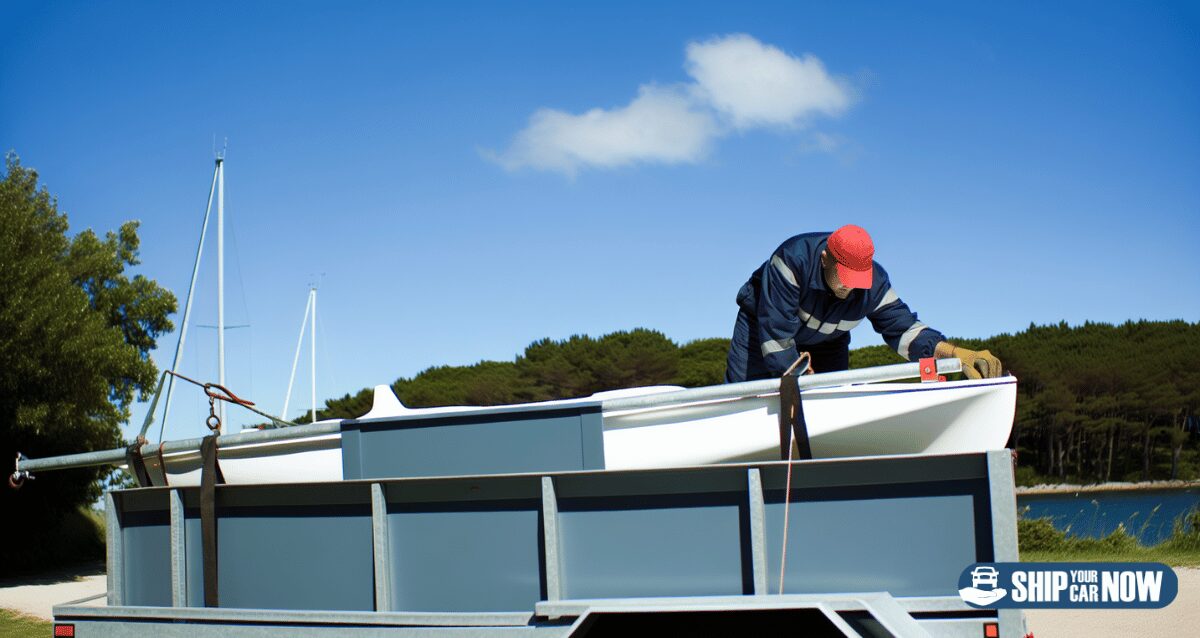How much does it cost to transport a boat? This is the definitive question for owners looking to move their vessels. Average boat transport costs can vary widely, typically ranging between $1.50 to $4 per mile, influenced by the boat’s dimensions, journey distance, and transportation mode [1]. Buckle up because it’s time to uncover the factors that affect boat transport costs in detail and guide you to smart, cost-effective boat shipping solutions.
Key Takeaways
- Boat transport costs are influenced by multiple factors, including the boat’s dimensions, the distance for shipment, and the chosen transport method. Prices range between $1.50 and $4 per mile.
- Additional costs in boat shipping may arise from preparation services, permits, escorts, port fees, crew salaries, and insurance, requiring careful budget forecasting.
- Selecting a reputable boat shipping company is crucial. The company should be chosen based on its reputation, transparency in pricing and payment terms, and experience with international shipping regulations.
Deciphering Your Boat Transport Cost

As we chart our course through this discussion like seasoned mariners interpreting shifting breezes, we will delve into particulars that shape how much it takes to deliver your boat safely to its destination dock.
Size Matters: Impact of Boat Dimensions on Pricing
In the realm of boat transport, dimensions are critical – it’s not just about how long your boat is. The width (beam), height, and total mass significantly influence the ebb and flow of boat transport expenses. Just as a grand sail on a ship catches ample wind, transporting larger boats entails additional demands for those in charge: advanced equipment, meticulous attention during handling, and sometimes unique arrangements to handle their sizeable presence. These added complexities naturally cause an uptick in the price tag associated with moving these majestic vessels.
On one end of the spectrum are smaller boats that anchor themselves within more economical tiers of boat transportation costs. Conversely, at the opposite end hover larger boats that hoist prices upward along with their heftier measurements. It is essential for boat owners to weigh how their vessel’s dimensions will impact financial planning when considering transportation needs.
Distance and Destination: How They Shape Transportation Costs

No matter if your transportation needs involve staying within national borders or crossing into international territory, the extent of travel exerts as much influence over transportation expenses as shorelines do upon ocean currents.
Choosing Your Transport Method: Options and Their Costs

As you deliberate over methods akin to picking between nimble clippers or solid frigates for your journey at sea. Enclosed containers present a higher cost option but afford protection from weather conditions for your boat, while roll-on/roll-off services provide less costly yet unprotected conveyance possibilities. Decisions here can dictate whether one’s experience is fraught with difficulty or plain sailing ahead.
The Economics of Boat Shipping: Calculating Your Expenses

On average, road transportation for boats can range from $1.50 per mile up to $4 per mile, depending on how far your craft must travel [3]. While smaller vessels may benefit from more gentle financial demands, larger boats venture into stronger currents of elevated expenses. It’s an ocean full of figures. By mapping out precise cost evaluations, you’ll be able to steer through these monetary waters effectively.
Per Mile Breakdown: Understanding Rates and Fees
When planning the finances for your boat journey, consider the per-mile cost as a key navigational tool. This rate decreases as you travel. Offering more favorable prices per nautical mile to those who undertake extended voyages. The size of your craft plays a significant role in this equation. Smaller vessels benefit from reduced costs, while their larger counterparts face increased expenses.
Regardless of whether you’re traversing land or navigating waters, grasping the concept of per-mile expenses is crucial—akin to being proficient with knots in sailing lore—as it provides a transparent projection of what your trip will entail financially.
Additional Services and Fees: What to Expect
Navigating the waters of boat shipping can bring with it a host of unforeseen expenses akin to sudden storms at sea. These might encompass:
- Services for preparation and packaging
- Acquisition of permits and provision of escorts
- Charges levied by ports
- Wages for onboard personnel
- Coverage provided by insurance policies
Just as one may experience gentle breezes from services related to preparation and packing or encounter more forceful winds in securing permits and arranging escorts, traversing maritime routes may also lead you through the swells raised by port charges alongside the strong undercurrents necessitated by crew wages. Equally important is mooring your investment securely within the protective embrace offered by comprehensive insurance coverage – an essential buffer against unpredictable marine upheavals.
Anticipating these ancillary expenditures mirrors the prudence required in readying oneself for every potential atmospheric shift when sailing across oceans, indispensable preparations that ensure both safety and successful arrival at your intended haven.
Budget-Friendly Boat Moving: Tips to Save Money

Let’s take a look at these strategies and techniques designed to turn what could be a pricey venture into an economically sound passage.
Timing is Everything: Leveraging Off-Peak Seasons
In the domain of boat transport, timing is dictated by seasonal variations, much like location. During peak seasons, which typically include summer and holiday periods, demand soars, and with it, the cost to transport your vessel rises as if filling up a schooner’s sails. On the flip side, choosing off-peak seasons for boat transport—like late fall or winter—can yield more competitive rates. It’s akin to riding a favorable current that brings you economically to your port of call. Opting for these less busy times can be equated to seizing the tide at its most opportune moment—a strategy that often results in significant financial savings.
Consolidation Can Cut Costs: Multiple Boat Shipments
Embarking on a group voyage can offer more than camaraderie. For boat owners, it presents an opportunity to economize on boat transport. Grouping their vessels for transit enables them to share the expense burden much as they would pool supplies during an extended sea journey. Not only does this collective approach to moving boats prove cost-effective for each participant, but it also enhances the logistical operations of the carrier service, culminating in mutual benefits.
When preparing your next venture that requires transporting your vessel, consider uniting with other seafarers—such collaboration could help maintain fiscal balance.
Preparing Your Vessel for Transport: A Checklist
Before your boat embarks on its own journey, it requires careful preparation to ensure it arrives at its destination as pristine as it sets sail. Think of this as battening down the hatches before a storm; a thorough checklist can be the difference between a smooth passage and a troublesome transit. Some key steps to consider include:
- Securing the exterior
- Powering down systems
- Emptying water and fuel tanks
- Checking the bow’s tip and the stern’s center for readiness
By following these steps, you can ensure that your boat is prepared for whatever lies ahead.
With the right preparations, your vessel will be as seaworthy on land or sea as it is in the water.
Securing the Exterior: Protecting Your Investment
The boat’s hull endures the hardships of travel, similar to how veteran sailors’ faces reflect their experiences. A layer of wax is insufficient for protection. What’s needed is fortification from the multitude of natural threats that lurk ahead. By shrink-wrapping your vessel—especially its teak and non-skid areas—you are equipping it with a watertight garment against downpours. The act of safeguarding stainless steel and chrome embellishments or treating them with insulator wax resembles bestowing upon them armor to fend off saltwater corrosion.
In dealing with sails and antennas, disassembling them should be viewed as essential preventive maintenance, just like an astute skipper steering clear from well-known shallow waters. While securing adequate insurance coverage remains crucial in guarding against potential losses, averting harm before it strikes stands as a testament to true maritime wisdom.
Internal Preparations: Draining Water and Fuel Tanks
In the depths of the boat, ongoing efforts include emptying both water and fuel tanks. Lightening your vessel in this way makes it easier for whatever transportation you’ve selected to carry it and diminishes the chance of spills that could lead to extra expenses. It’s akin to clearing out bilges prior to setting sail – an essential measure for safeguarding the boat’s interior mechanisms.
By firmly stowing away personal effects and ensuring all hatches are tightly secured, you make certain that your boat is not only primed for transit but also poised for a serene voyage characterized by meticulous planning.
Selecting a Reliable Boat Shipping Company

We will delve into what sets apart a boat shipping company not merely as an acceptable option but rather as the premier pick for transporting your prized vessel.
Reputation and Reviews: Ensuring Quality Service
A boat transport company’s esteemed reputation is like a strong tailwind, pushing them ahead while providing boat owners with an indication of the quality they can anticipate. Boat owners must use their keen judgment to evaluate a company’s standing by scrutinizing online feedback, star ratings, and experiences shared by those who have previously enlisted their services. This gathered intelligence is akin to an essential weather report. It predicts whether you’re heading for choppy waters or expect smooth sailing on your journey. Navigating through this sea of diverse opinions can be done using platforms such as Yelp, Google Reviews, and Trust Pilot — these are modern tools to chart your course in selecting a trustworthy service.
Locating a dependable boat shipping enterprise that not only presents you with an elaborate quote for the transportation but also offers tracking capabilities signifies that you may very well have discovered one of the more reliable boat moving companies out there—one committed to guaranteeing secure delivery across vast distances.
Transparent Pricing and Payment Terms
Every boat owner yearns for straightforward and transparent pricing and payment conditions when selecting a transport company to ship their vessel. A dependable boat shipping company will steer through these requirements with expert skill, providing:
- Open communication free of surprises or concealed obstacles
- Tailored shipping options that cater specifically to individual requirements
- A customized quote that fits as perfectly as a well-crafted sail
When such a shipping company can present discounts yet still maintain high-quality service, it’s like catching the perfect breeze. If they can accommodate payment terms in harmony with your budgeting journey, then you’ve discovered an anchorage worth settling into.
Navigating International Waters: Overseas Boat Shipping
Boat shipping across international waters presents unique navigation challenges, akin to setting sail on an expedition that requires specialized knowledge and tools. The expenses involved in this journey fluctuate with various factors, including the distance to be traveled, the final destination, and the maritime routes taken. It’s essential for anyone undertaking this voyage to have a deep understanding of both local customs and international regulations so their boat arrives at its destination without unnecessary interruptions or legal issues.
When it comes down to deciding whether your boat should travel in enclosed containers or opt for Roll-on/Roll-off services during shipping, you must weigh up considerations related directly to safety concerns and practicality rather than mere personal choice. Let’s hoist our sails into learning about these critical elements one must ponder while preparing for overseas boat transport—information every shipmaster ought to look into before embarking on such a venture.
Understanding Customs and Regulations
Every international shipper must meticulously chart their course through the complex waters of customs and regulations. Ensuring that your boat adheres to the maritime laws of each nation it enters is critical, not merely a bureaucratic hurdle. Your paperwork should be as detailed as a captain’s log, capturing every aspect from the bill of lading to the certificate of origin.
As you navigate these global passages, expect to face an array of fees, duties, and taxes—each varying with the myriad countries your journey touches. Both pre-clearance procedures prior to departure and post-clearance protocols upon docking are essential links in securing your boat firmly at its next berth.
Enclosed Containers vs. Roll-on/Roll-off
Deciding between using enclosed containers and opting for Roll-on/Roll-off services can be likened to selecting a journey across the open sea versus navigating through narrow channels. Enclosed containers serve as robust vaults on the ocean, shielding your vessel from weather-related perils during transit, but they come at a premium price. This option is akin to purchasing peace of mind, ensuring that your boat arrives in pristine condition, unaffected by corrosive marine elements.
Conversely, with Roll-on/Roll-off services, boats are secured out in the open air on deck, exposed and susceptible to atmospheric conditions. It’s rolling dice with climatic uncertainties. If luck prevails, it leads to reduced expenditures along with uncomplicated embarkation processes. Much like plotting a careful path among coral shoals, it depends heavily on what dangers you’re ready to face and how much safeguarding your boat necessitates.
ShipYourCarNow: Navigating Excellence in Boat Shipping with Unmatched Reliability and Commitment

With services designed for both convenience and dependability, we ensure the timely arrival and immaculate condition of your vessel upon delivery. Our unwavering dedication mirrors the protective care professional boat transporters should provide – making certain that every aspect reflects our dedication as you entrust us with the responsibility of transporting your boat.
Full Summary
As we dock at the end of our voyage through the intricacies of boat transport, we reflect on the vast sea of information we’ve traversed. From deciphering the costs influenced by size, distance, and transport method to the strategic timing for off-peak shipping and the consolidation of shipments. We’ve prepared our vessel for transport and chosen a shipping company with a sturdy reputation and transparent terms. We’ve even navigated the international shipping waters, understanding the importance of customs and choosing the right shipping service. The journey of moving a boat is complex and filled with as many details as there are stars in a sailor’s night sky. But with this comprehensive guide, we’ve charted a course that should make the process as smooth as glassy waters, leaving you ready to set sail on your next great adventure.
Frequently Asked Questions
How much does it cost to move a 40-foot boat?
Shipping a 40-foot boat over distances shorter than 1,000 miles can cost from $1 to $3 per mile, which is more affordable than transporting it by road, which ranges between $2.75 and $3.75 per mile. Opting for a crew to navigate the boat might be an even more cost-effective method, as expenses could span from nothing up to just $1.50 per mile. This option requires greater time and effort commitment.
How does boat transportation work?
Transporting a boat entails moving the vessel to a different place via land, sea, or even air. This often involves towing the boat with a vehicle but can also necessitate using specialized vehicles designed for such transportation needs.
How much does it cost to transport a boat from Florida to California?
The expense of shipping a boat from Florida to California typically ranges from $3,000 to $5,000. On average, the cost for road and rail transport is about $1.50 to $3.75 per mile while maritime transportation costs vary significantly between $1.25 and $15.00 per mile depending on various factors such as the distance your vessel needs to cover and its dimensions which are crucial for determining an accurate estimate of the shipping costs.
What factors most significantly affect boat transport costs?
Boat size, the distance to be transported, and the selected method of transportation are key elements that substantially influence the expenses associated with boat transport. Typically, costs escalate with larger boats and when transporting over greater distances.
Senior automotive logistics professional with a passion for the industry and a 10+ year history of accomplishments. Proven track record of exemplary client management working with both RMCs, Van Lines and OEMs. Keen ability to react to an ever-changing marketplace while offering superior technology solutions, programs and services. Architect of award winning auto transport portal technology offering transparency and agility to clients, agents and transferees. Successful team builder and leader easily managing budgets with effective leadership, strategic planning, and problem-solving capabilities.

















